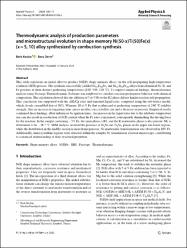| dc.contributor.author | Keskin, Berk | |
| dc.contributor.author | Derin, Bora | |
| dc.date.accessioned | 2024-03-08T06:03:20Z | |
| dc.date.available | 2024-03-08T06:03:20Z | |
| dc.date.issued | 2024 | en_US |
| dc.identifier.citation | Keskin, B. ve Derin, B. (2024). Thermodynamic analysis of production parameters and microstructural evolution in shape memory Ni(50-x)Ti(50)Fe(x) (x = 5, 10) alloy synthesized by combustion synthesis. Applied Physics A: Materials Science and Processing, 130(3). https://dx.doi.org/10.1007/s00339-024-07306-z | en_US |
| dc.identifier.issn | 0947-8396 | |
| dc.identifier.issn | 1432-0630 | |
| dc.identifier.uri | https://dx.doi.org/10.1007/s00339-024-07306-z | |
| dc.identifier.uri | https://hdl.handle.net/20.500.12511/12345 | |
| dc.description.abstract | This study represents an initial effort to produce NiTiFe shape memory alloys via the self-propagating high-temperature synthesis (SHS) process. The synthesis successfully yielded Ni45Ti50Fe5 and Ni40Ti50Fe10 alloys from elemental Ni, Ti, and Fe powders at three distinct preheating temperatures (240, 330, 420 °C). To support empirical findings, thermodynamic analysis using Factsage Thermodynamic Software was employed to correlate reaction propagation behavior with chemical composition. The calculation showed that the addition of 5 at.% Fe to the B2 phase did not hinder reaction self-propagation. This conclusion was supported with the ∆Hf/Cp ratio and transient liquid ratio, computed using the sub-lattice model, which closely resembled that of NiTi. Whereas 10 at.% Fe that synthesized at preheating temperature of 240 °C exhibits struggle, thus an increase in triggering time causes an effect on crystallite size and a decrease in porosity. Empirical results confirmed these findings, albeit influenced by ignition times. An increase in the liquid ratio due to the adiabatic temperature rise can also result in a reduction of NiTi content when the Fe ratio is increased, consequently diminishing the driving force for the reaction. In the sample containing – 5% Fe, the main phase is B2, and the R martensitic phase is also present. Ms is determined to be – 38.7 °C. SEM analyses revealed the presence of Ti2Ni and Ti2Ni3 phases in the upper and lower regions, while the distribution in the middle section is more homogeneous. No martensitic transformation was observed in 10% Fe. Additionally, nanocrystalline regions were detected within the samples by transmission electron microscopy, contributing to a nuanced understanding of their structural properties. Graphic abstract: (Figure presented.). | en_US |
| dc.language.iso | eng | en_US |
| dc.publisher | Springer Science and Business Media Deutschland GmbH | en_US |
| dc.rights | info:eu-repo/semantics/openAccess | en_US |
| dc.rights | Attribution 4.0 International | * |
| dc.rights.uri | https://creativecommons.org/licenses/by/4.0/ | * |
| dc.subject | Factsage | en_US |
| dc.subject | NiTiFe | en_US |
| dc.subject | Shape Memory Alloys | en_US |
| dc.subject | SHS | en_US |
| dc.subject | Thermodynamic | en_US |
| dc.title | Thermodynamic analysis of production parameters and microstructural evolution in shape memory Ni(50-x)Ti(50)Fe(x) (x = 5, 10) alloy synthesized by combustion synthesis | en_US |
| dc.type | article | en_US |
| dc.relation.ispartof | Applied Physics A: Materials Science and Processing | en_US |
| dc.department | İstanbul Medipol Üniversitesi, İMÜ Meslek Yüksekokulu, İnşaat Teknolojisi Ana Bilim Dalı | en_US |
| dc.authorid | 0000-0003-3640-2805 | en_US |
| dc.identifier.volume | 130 | en_US |
| dc.identifier.issue | 3 | en_US |
| dc.relation.tubitak | info:eu-repo/grantAgreement/TUBITAK/SOBAG/213M556 | |
| dc.relation.publicationcategory | Makale - Uluslararası Hakemli Dergi - Kurum Öğretim Elemanı | en_US |
| dc.identifier.doi | 10.1007/s00339-024-07306-z | en_US |
| dc.institutionauthor | Keskin, Berk | |
| dc.identifier.wosquality | Q2 | en_US |
| dc.identifier.wos | 001163702500001 | en_US |
| dc.identifier.scopus | 2-s2.0-85185281398 | en_US |
| dc.identifier.scopusquality | Q2 | en_US |



















